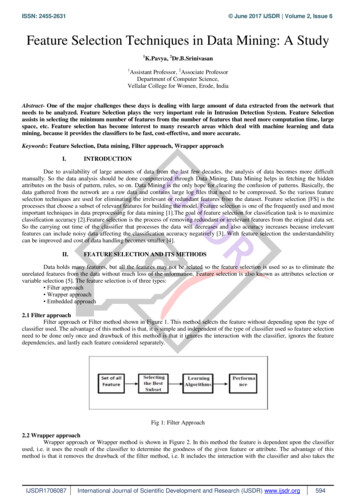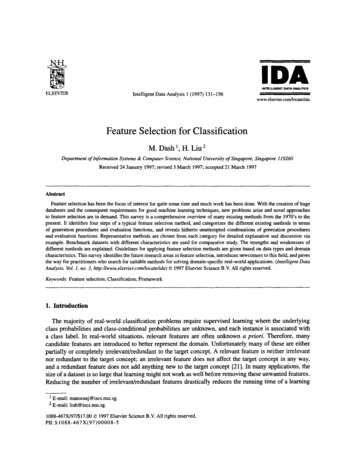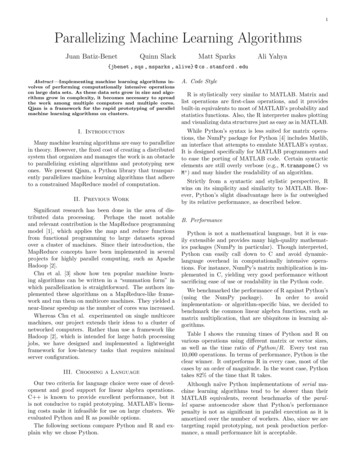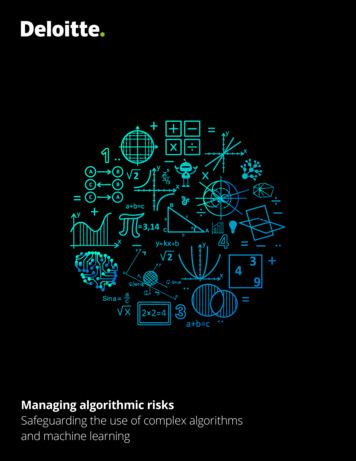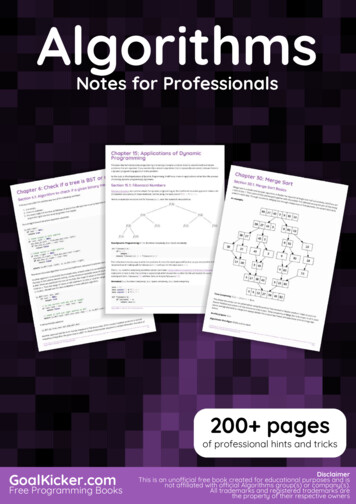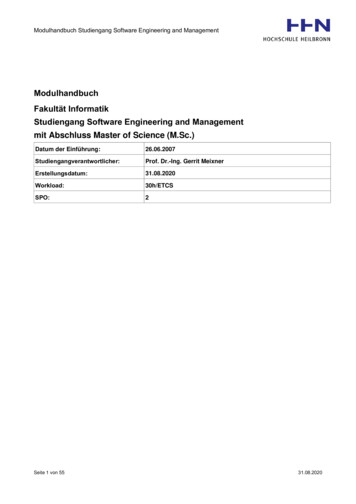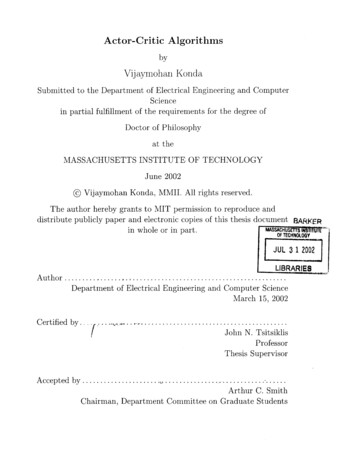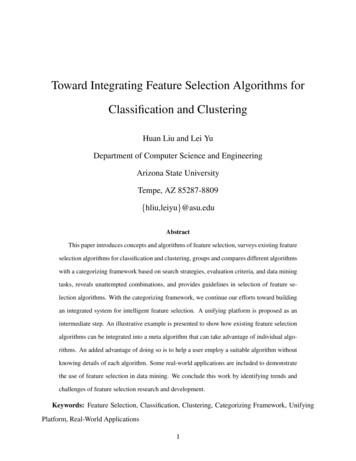
Transcription
Toward Integrating Feature Selection Algorithms forClassification and ClusteringHuan Liu and Lei YuDepartment of Computer Science and EngineeringArizona State UniversityTempe, AZ 85287-8809{hliu,leiyu}@asu.eduAbstractThis paper introduces concepts and algorithms of feature selection, surveys existing featureselection algorithms for classification and clustering, groups and compares different algorithmswith a categorizing framework based on search strategies, evaluation criteria, and data miningtasks, reveals unattempted combinations, and provides guidelines in selection of feature selection algorithms. With the categorizing framework, we continue our efforts toward buildingan integrated system for intelligent feature selection. A unifying platform is proposed as anintermediate step. An illustrative example is presented to show how existing feature selectionalgorithms can be integrated into a meta algorithm that can take advantage of individual algorithms. An added advantage of doing so is to help a user employ a suitable algorithm withoutknowing details of each algorithm. Some real-world applications are included to demonstratethe use of feature selection in data mining. We conclude this work by identifying trends andchallenges of feature selection research and development.Keywords: Feature Selection, Classification, Clustering, Categorizing Framework, UnifyingPlatform, Real-World Applications1
1 IntroductionAs computer and database technologies advance rapidly, data accumulates in a speed unmatchableby human’s capacity of data processing. Data mining [1, 29, 35, 36], as a multidisciplinary jointeffort from databases, machine learning, and statistics, is championing in turning mountains of datainto nuggets. Researchers and practitioners realize that in order to use data mining tools effectively,data preprocessing is essential to successful data mining [53, 74]. Feature selection is one of theimportant and frequently used techniques in data preprocessing for data mining [6, 52]. It reducesthe number of features, removes irrelevant, redundant, or noisy data, and brings the immediateeffects for applications: speeding up a data mining algorithm, improving mining performance suchas predictive accuracy and result comprehensibility. Feature selection has been a fertile field ofresearch and development since 1970’s in statistical pattern recognition [5, 40, 63, 81, 90], machinelearning [6, 41, 43, 44], and data mining [17, 18, 42], and widely applied to many fields such astext categorization [50, 70, 94], image retrieval [77, 86], customer relationship management [69],intrusion detection [49], and genomic analysis [91].Feature selection is a process that selects a subset of original features. The optimality of afeature subset is measured by an evaluation criterion. As the dimensionality of a domain expands,the number of features N increases. Finding an optimal feature subset is usually intractable [44]and many problems related to feature selection have been shown to be NP-hard [7]. A typicalfeature selection process consists of four basic steps (shown in Figure 1), namely, subset generation, subset evaluation, stopping criterion, and result validation [18]. Subset generation is a searchprocedure [48, 53] that produces candidate feature subsets for evaluation based on a certain searchstrategy. Each candidate subset is evaluated and compared with the previous best one accordingto a certain evaluation criterion. If the new subset turns out to be better, it replaces the previousbest subset. The process of subset generation and evaluation is repeated until a given stopping criterion is satisfied. Then the selected best subset usually needs to be validated by prior knowledgeor different tests via synthetic and/or real-world data sets. Feature selection can be found in manyareas of data mining such as classification, clustering, association rules, regression. For example,2
oodnessof subsetNoStoppingCriterionYesResultValidationFigure 1: Four key steps of feature selectionfeature selection is called subset or variable selection in Statistics [62]. A number of approaches tovariable selection and coefficient shrinkage for regression are summarized in [37]. In this survey,we focus on feature selection algorithms for classification and clustering. Early research effortsmainly focus on feature selection for classification with labeled data [18, 25, 81] (supervised feature selection) where class information is available. Latest developments, however, show that theabove general procedure can be well adopted to feature selection for clustering with unlabeleddata [19, 22, 27, 87] (or unsupervised feature selection) where data is unlabeled.Feature selection algorithms designed with different evaluation criteria broadly fall into threecategories: the filter model [17, 34, 59, 95], the wrapper model [13, 27, 42, 44], and the hybridmodel [15, 68, 91]. The filter model relies on general characteristics of the data to evaluate andselect feature subsets without involving any mining algorithm. The wrapper model requires onepredetermined mining algorithm and uses its performance as the evaluation criterion. It searchesfor features better suited to the mining algorithm aiming to improve mining performance, but italso tends to be more computationally expensive than the filter model [44, 48]. The hybrid modelattempts to take advantage of the two models by exploiting their different evaluation criteria indifferent search stages.This survey attempts to review the field of feature selection based on earlier works by Doak [25],Dash and Liu [18], and Blum and Langley [6]. The fast development of the field has producedmany new feature selection methods. Novel research problems and applications emerge, and newdemands for feature selection appear. In order to review the field and attempt for the next genera3
tion of feature selection methods, we aim to achieve the following objectives in this survey: introduce the basic notions, concepts, and procedures of feature selection, describe the state-of-the-art feature selection techniques, identify existing problems of feature selection and propose ways of solving them, demonstrate feature selection in real-world applications, and point out current trends and future directions.This survey presents a collection of existing feature selection algorithms, and proposes a categorizing framework that systematically groups algorithms into categories and compares the commonalities and differences between the categories. It further addresses a problem springing fromthe very core of the success of this field - a dilemma faced by most data mining practitioners: themore feature selection algorithms available, the more difficult it is to select a suitable one for a datamining task. This survey, therefore, proposes a unifying platform that covers major factors in theselection of a suitable algorithm for an application, and paves the way for building an integratedsystem for intelligent feature selection.The remainder of this paper is organized into five sections. Section 2 describes each step ofthe general feature selection process. Section 3 groups and compares different feature selectionalgorithms based on a three-dimensional categorizing framework. Section 4 introduces the development of a unifying platform and illustrates the idea of developing an integrated system forintelligent feature selection through a preliminary system. Section 5 demonstrates some real-worldapplications of feature selection in data mining. Section 6 concludes the survey with discussionson current trends and future directions.2 General Procedure of Feature SelectionIn this section, we explain in detail the four key steps as shown in Figure 1 of Section 1.4
2.1Subset generationSubset generation is essentially a process of heuristic search, with each state in the search spacespecifying a candidate subset for evaluation. The nature of this process is determined by two basicissues. First, one must decide the search starting point (or points) which in turn influences thesearch direction. Search may start with an empty set and successively add features (i.e., forward),or start with a full set and successively remove features (i.e., backward), or start with both endsand add and remove features simultaneously (i.e., bi-directional). Search may also start with arandomly selected subset in order to avoid being trapped into local optima [25]. Second, one mustdecide a search strategy. For a data set with N features, there exist 2N candidate subsets. Thissearch space is exponentially prohibitive for exhaustive search with even a moderate N . Therefore,different strategies have been explored: complete, sequential, and random search.Complete searchIt guarantees to find the optimal result according to the evaluation criterion used. Exhaustivesearch is complete (i.e., no optimal subset is missed). However, search is complete does not necessarily means that it must be exhaustive. Different heuristic functions can be used to reduce thesearch space without jeopardizing the chances of finding the optimal result. Hence, although theorder of the search space is O(2N ), a smaller number of subsets are evaluated. Some examples arebranch and bound [67], and beam search [25].Sequential searchIt gives up completeness and thus risks losing optimal subsets. There are many variationsto the greedy hill-climbing approach, such as sequential forward selection, sequential backwardelimination, and bi-directional selection [53]. All these approaches add or remove features oneat a time. Another alternative is to add (or remove) p features in one step and remove (or add) qfeatures in the next step (p q) [25]. Algorithms with sequential search are simple to implementand fast in producing results as the order of the search space is usually O(N 2 ) or less.Random searchIt starts with a randomly selected subset and proceeds in two different ways. One is to follow5
sequential search, which injects randomness into the above classical sequential approaches. Examples are random-start hill-climbing and simulated annealing [25]. The other is to generate thenext subset in a completely random manner (i.e., a current subset does not grow or shrink from anyprevious subset following a deterministic rule), also known as the Las Vegas algorithm [10]. Forall these approaches, the use of randomness helps to escape local optima in the search space, andoptimality of the selected subset depends on the resources available.2.2Subset evaluationAs we mentioned earlier, each newly generated subset needs to be evaluated by an evaluation criterion. The goodness of a subset is always determined by a certain criterion (i.e., an optimal subsetselected using one criterion may not be optimal according to another criterion). Evaluation criteriacan be broadly categorized into two groups based on their dependency on mining algorithms thatwill finally be applied on the selected feature subset. We discuss the two groups of evaluationcriteria below.2.2.1Independent criteriaTypically, an independent criterion is used in algorithms of the filter model. It tries to evaluate thegoodness of a feature or feature subset by exploiting the intrinsic characteristics of the training datawithout involving any mining algorithm. Some popular independent criteria are distance measures,information measures, dependency measures, and consistency measures [3, 5, 34, 53].Distance measures are also known as separability, divergence, or discrimination measures. Fora two-class problem, a feature X is preferred to another feature Y if X induces a greater differencebetween the two-class conditional probabilities than Y, because we try to find the feature that canseparate the two classes as far as possible. X and Y are indistinguishable if the difference is zero.Information measures typically determine the information gain from a feature. The information gain from a feature X is defined as the difference between the prior uncertainty and expectedposterior uncertainty using X. Feature X is preferred to feature Y if the information gain from X is6
greater than that from Y.Dependency measures are also known as correlation measures or similarity measures. Theymeasure the ability to predict the value of one variable from the value of another. In featureselection for classification, we look for how strongly a feature is associated with the class. Afeature X is preferred to another feature Y if the association between feature X and class C ishigher than the association between Y and C. In feature selection for clustering, the associationbetween two random features measures the similarity between the two.Consistency measures are characteristically different from the above measures because oftheir heavy reliance on the class information and the use of the Min-Features bias [3] in selectinga subset of features. These measures attempt to find a minimum number of features that separateclasses as consistently as the full set of features can. An inconsistency is defined as two instanceshaving the same feature values but different class labels.2.2.2Dependency criteriaA dependency criterion used in the wrapper model requires a predetermined mining algorithm infeature selection and uses the performance of the mining algorithm applied on the selected subsetto determine which features are selected. It usually gives superior performance as it finds featuresbetter suited to the predetermined mining algorithm, but it also tends to be more computationallyexpensive, and may not be suitable for other mining algorithms [6]. For example, in a task ofclassification, predictive accuracy is widely used as the primary measure. It can be used as adependent criterion for feature selection. As features are selected by the classifier that later on usesthese selected features in predicting the class labels of unseen instances, accuracy is normally high,but it is computationally rather costly to estimate accuracy for every feature subset [41].In a task of clustering, the wrapper model of feature selection tries to evaluate the goodness ofa feature subset by the quality of the clusters resulted from applying the clustering algorithm on theselected subset. There exist a number of heuristic criteria for estimating the quality of clusteringresults, such as cluster compactness, scatter separability, and maximum likelihood. Recent work7
on developing dependent criteria in feature selection for clustering can been found in [20, 27, 42].2.3Stopping criteriaA stopping criterion determines when the feature selection process should stop. Some frequentlyused stopping criteria are: (a) the search completes; (b) some given bound is reached, where abound can be a specified number (minimum number of features or maximum number of iterations);(c) subsequent addition (or deletion) of any feature does not produce a better subset; and (d) asufficiently good subset is selected (e.g., a subset may be sufficiently good if its classification errorrate is less than the allowable error rate for a given task).2.4Result validationA straightforward way for result validation is to directly measure the result using prior knowledgeabout the data. If we know the relevant features beforehand as in the case of synthetic data, wecan compare this known set of features with the selected features. Knowledge on the irrelevant orredundant features can also help. We do not expect them to be selected. In real-world applications,however, we usually do not have such prior knowledge. Hence, we have to rely on some indirectmethods by monitoring the change of mining performance with the change of features. For example, if we use classification error rate as a performance indicator for a mining task, for a selectedfeature subset, we can simply conduct the “before-and-after” experiment to compare the error rateof the classifier learned on the full set of features and that learned on the selected subset [53, 89].3 A Categorizing Framework for Feature Selection AlgorithmsGiven the key steps of feature selection, we now introduce a categorizing framework that groupsmany existing feature selection algorithms into distinct categories, and summarize individual algorithms based on this framework.8
Table 1: Categorization of feature selection algorithms in a three-dimensional frameworkSearch StrategiesSequentialRelief [43]ReliefF [47]ReliefS [57]SFS [73]Segen’s [79]DTM [12]Dash’s [17]Koller’s [46]SBUD [22]SFG [53]FCBF [95]CFS [34]Mitra’s[63]RRESET [64]POE ACC [66]DVMM [83]Set Cover [16]CompleteB&B [67]BFF [92]DistanceMDLM [80]Evaluation CriteriaFilterInformationBobrowski’s [8]DependencyHybridWrapperConsistencyPredictive AccuracyorCluster GoodnessFocus [2]ABB [56]MIFES1 [71]Schlimmer’s [77]BS [25]AMB&B [31]FSLC [38]FSBC [39]Filter WrapperClassification3.1SBS-SLASH [13]WSFG [24]WSBG [24]BDS [25]PQSS [25]RC [26]SS [65]Queiros’ [75]BBHFS [15]Xing’s [91]ClusteringAICC [23]FSSEM [27]ELSA [42]RandomLVI [53]QBB [53]LVF [59]SA [25]RGSS [25]LVW [58]RMHC-PF [82]GA [88] [93]RVE [85]Dash-Liu’s [20]ClassificationClusteringData Mining TasksClassificationClusteringA categorizing frameworkThere exists a vast body of available feature selection algorithms. In order to better understandthe inner instrument of each algorithm and the commonalities and differences among them, wedevelop a three-dimensional categorizing framework (shown in Table 1) based on the previous discussions. We understand that search strategies and evaluation criteria are two dominating factors indesigning a feature selection algorithm, so they are chosen as two dimensions in the framework. InTable 1, under Search Strategies, algorithms are categorized into Complete, Sequential, and Random. Under Evaluation Criteria, algorithms are categorized into Filter, Wrapper, and Hybrid.We consider Data Mining Tasks as a third dimension because the availability of class informationin Classification or Clustering tasks affects evaluation criteria used in feature selection algorithms9
(as discussed in Section 2.2). In addition to these three basic dimensions, algorithms within theFilter category are further distinguished by specific evaluation criteria including Distance, Information, Dependency, and Consistency. Within the Wrapper category, Predictive Accuracy is usedfor Classification, and Cluster Goodness for Clustering.Many feature selection algorithms collected in Table 1 can be grouped into distinct categoriesaccording to these characteristics. The categorizing framework serves three roles. First, it revealsrelationships among different algorithms: algorithms in the same block (category) are most similar to each other (i.e., designed with similar search strategies and evaluation criteria, and for thesame type of data mining tasks). Second, it enables us to focus our selection of feature selectionalgorithms for a given task on a relatively small number of algorithms out the whole body. Forexample, knowing that feature selection is performed for classification, predicative accuracy of aclassifier is suitable to be the evaluation criterion, and complete search is not suitable for the limited time allowed, we can conveniently limit our choices to two groups of algorithms in Table 1:one is defined by Classification, Wrapper, and Sequential; the other is by Classification, Wrapper,and Random. Both groups have more than one algorithm available 1 . Third, the framework alsoreveals what are missing in the current collection of feature selection algorithms. As we can see,there are many empty blocks in Table 1, indicating that no feature selection algorithm exists forthese combinations which might be suitable for potential future work. In particular, for example,current feature selection algorithms for clustering are only limited to sequential search.With a large number of existing algorithms seen in the framework, we summarize all the algorithms into three generalized algorithms corresponding to the filter model, the wrapper model, andthe hybrid model, respectively.1Some other perspectives are necessary to further differentiate algorithms in each category. In-depth discussionson choosing a most suitable feature selection algorithm for a data mining problem is provided in Section 4.10
3.2Filter AlgorithmAlgorithms within the filter model are illustrated through a generalized filter algorithm (shownin Table 2). For a given data set D, the algorithm starts the search from a given subset S0 (anempty set, a full set, or any randomly selected subset) and searches through the feature space bya particular search strategy. Each generated subset S is evaluated by an independent measure Mand compared with the previous best one. If it is found to be better, it is regarded as the currentbest subset. The search iterates until a predefined stopping criterion δ (as described in Section 2.3)is reached. The algorithm outputs the last current best subset Sbest as the final result. By varyingthe search strategies and evaluation measures used in steps 5 and 6 in the algorithm, we can designdifferent individual algorithms within the filter model. Since the filter model applies independentevaluation criteria without involving any mining algorithm, it does not inherit any bias of a miningalgorithm and it is also computationally efficient.Table 2: A generalized filter algorithmFilter Algorithminput:D(F0 , F1 , ., Fn 1 ) // a training data set with N features// a subset from which to start the searchS0δ// a stopping criterion// an optimal subsetoutput: Sbest01 begin02initialize: Sbest S0 ;03γbest eval(S0 , D, M ); // evaluate S0 by an independent measure M04do begin05S generate(D); // generate a subset for evaluation06γ eval(S, D, M ); // evaluate the current subset S by M07if (γ is better than γbest )08γbest γ;09Sbest S;10end until (δ is reached);11return Sbest ;12 end;11
3.3Wrapper AlgorithmA generalized wrapper algorithm (shown in Table 3) is very similar to the generalized filter algorithm except that it utilizes a predefined mining algorithm A instead of an independent measureM for subset evaluation. For each generated subset S, it evaluates its goodness by applying themining algorithm to the data with feature subset S and evaluating the quality of mined results.Therefore, different mining algorithms will produce different feature selection results. Varying thesearch strategies via the function generate(D) and mining algorithms (A) can result in differentwrapper algorithms. Since mining algorithms are used to control the selection of feature subsets,the wrapper model tends to give superior performance as feature subsets found are better suitedto the predetermined mining algorithm. Consequently, it is also more computationally expensivethan the filter model.Table 3: A generalized wrapper algorithmWrapper Algorithminput:D(F0 , F1 , ., Fn 1 ) // a training data set with N features// a subset from which to start the searchS0δ// a stopping criterion// an optimal subsetoutput: Sbest01 begin02initialize: Sbest S0 ;03γbest eval(S0 , D, A); // evaluate S0 by a mining algorithm A04do begin05S generate(D); // generate a subset for evaluation06γ eval(S, D, A); // evaluate the current subset S by A07if (γ is better than γbest )08γbest γ;09Sbest S;10end until (δ is reached);11return Sbest ;12 end;3.4Hybrid AlgorithmTo take advantage of the above two models and avoid the pre-specification of a stopping criterion,the hybrid model is recently proposed to handle large data sets [15, 91]. A typical hybrid algorithm12
Table 4: A generalized hybrid algorithmHybrid Algorithminput:D(F0 , F1 , ., Fn 1 ) // a training data set with N features// a subset from which to start the searchS0// an optimal subsetoutput: Sbest01 begin02initialize: Sbest S0 ;03c0 card(S0 ); // calculate the cardinality of S004γbest eval(S0 , D, M ); // evaluate S0 by an independent measure M05θbest eval(S0 , D, A); // evaluate S0 by a mining algorithm A06for c c0 1 to N begin07for i 0 to N c begin08S Sbest {Fj }; // generate a subset with cardinality c for evaluation09γ eval(S, D, M ); // evaluate the current subset S by M10if (γ is better than γbest )11γbest γ; S;12Sbest13end; , D, A); // evaluate Sbestby A14θ eval(Sbest15if (θ is better than θbest ); ;16Sbest Sbest17θbest θ;18else;19break and return Sbest ;20end;21return Sbest ;22 end;(shown in Table 4) makes use of both an independent measure and a mining algorithm to evaluatefeature subsets: it uses the independent measure to decide the best subsets for a given cardinalityand uses the mining algorithm to select the final best subset among the best subsets across different cardinalities. Basically, it starts the search from a given subset S0 (usually an empty set insequential forward selection) and iterates to find the best subsets at each increasing cardinality. Ineach round for a best subset with cardinality c, it searches through all possible subsets of cardinality c 1 by adding one feature from the remaining features. Each newly generated subset Swith cardinality c 1 is evaluated by an independent measure M and compared with the previous best one. If S is better, it becomes the current best subset Sbestat level c 1. At the end of each iteration, a mining algorithm A is applied on Sbestat level c 1 and the quality of the mined result is better, the algorithm continuesθ is compared with that from the best subset at level c. If Sbest13
to find the best subset at the next level; otherwise, it stops and outputs the current best subset asthe final best subset. The quality of results from a mining algorithm provides a natural stoppingcriterion in the hybrid model.4 Toward an Integrated System for Intelligent FeatureSelectionResearch on feature selection has been active for decades with attempts to improve well-knownalgorithms or to develop new ones. The proliferation of feature selection algorithms, however,has not brought about a general methodology that allows for intelligent selection from existingalgorithms. In order to make a “right” choice, a user not only needs to know the domain well(this is usually not a problem for the user), but also is expected to understand technical details ofavailable algorithms (discussed in previous sections). Therefore, the more algorithms available,the more challenging it is to choose a suitable one for an application. Consequently, a big number of algorithms are not even attempted in practice and only a couple of algorithms are alwaysused. Therefore, there is a pressing need for intelligent feature selection that can automaticallyrecommend the most suitable algorithm among many for a given application. In this section, wepresent an integrated approach to intelligent feature selection. First, we introduce a unifying platform which serves an intermediate step toward building an integrated system for intelligent featureselection. Second, we illustrate the idea through a preliminary system based on our research.4.1A unifying platformIn Section 3.1, we develop a categorizing framework based on three dimensions (search strategies,evaluation criteria, and data mining tasks) from an algorithm designer’s perspective. However, itwould be impractical to require a domain expert or a user to keep abreast of such technical detailsabout feature selection algorithms. Moreover, in most cases, it is not sufficient to decide the most14
Feature SelectionUnusualUsualN/I RatioGoodQualityMissing ValueNominalDiscreteNoFeature TypeContinuousYesMinimum SubsetClass InfoUnknownM/N RatioKnownOutput TypeRanked ListNon NoiseKnowledgeFigure 2: A unifying platformsuitable algorithm based merely on this framework. Recall the two groups of algorithms identifiedby the three dimensions in Section 3.1, each group still contains quite a few candidate algorithms.Assuming that we only have three wrapper algorithms: WSFG and WSBG in one group and LVWin the other group, additional information is required to decide the most suitable one for the giventask. We propose a unifying platform (shown in Figure 2) that expands the categorizing frameworkby introducing more dimensions from a user’s perspective.At the top, knowledge and data about feature selection are two key determining factors. Currently the knowledge factor covers Purpose of feature selection, Time concern, expected OutputType, and M/N Ratio - the ratio between the expected number of selected features M and the totalnumber of original features N . The data factor covers Class Information, Feature Type, Quality ofdata, and N/I Ratio - the ratio between the number of features N and the number of instances I.Each dimension is discussed below.The purpose of feature selection can be broadly categorized into visualization, data understanding, data cleaning, redundancy and/or irrelevancy removal, and performance (e.g., predictiveaccuracy and comprehensibility) enhancement. Recall that feature selection algorithms are categorized into the filter model, the wrapper model, and the hybrid model. Accordingly, we can alsosummarize different purposes of feature selection into these three categories to form a generic task15
hierarchy, as different purposes imply different evaluation criteria and thus guide the selection offeature selection algorithms differently. For general purpose of redundancy and/or irrelevancy removal, algorithms in the filter model are good choices as they are unbiased and fast. To enhancethe mining performance, algorithms in the wrapper model should be preferred than those in thefilter model as they are better suited to the mining algorithms[44, 48]. Sometimes, algorithms inthe hybrid model are needed to serve more complicated purposes.The time concern is about whether the feature selection process is time critical or not. Different
data preprocessing is essential to successful data mining [53, 74]. Feature selection is one of the important and frequently used techniques in data preprocessing for data mining [6, 52]. It reduces the number of features, removes irrelevant, redundant, or noisy data, and brings the immediate effects for applications: speeding up a data mining .

